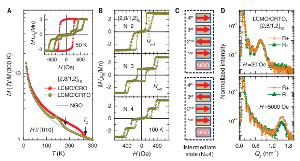Jul 19 2017
In the early 1930s, Louis Néel discovered the abnormality that specific materials that consist of magnetic elements and exhibiting zero remanence at any temperature did not conform to the paramagnetic Curie law.
Since then, the constant low-temperature susceptibility behind this phenomenon (termed as antiferromagnet, or AFM) has gained great attention and has been used in various applications, particularly in the field of enhanced computer memory units.
 AF-IEC in LCMO/ CRTO multilayers. (A) Temperature (T) dependence of normalized magnetization (M) measured in LCMO/CRTO and LCMO/CRO SLs, [2.8/1.2]10. The paramagnetic background from the NGO(001) substrates is included for comparison. During these measurements, a cooling field of 250 Oe is applied along the in-plane easy-axis [010]. The inset shows the corresponding hysteresis loops measured at 50 K from each SL, with the paramagnetic background from the NGO substrate subtracted (figs. S3 and S4).(B) Hysteresis loops measured at 100 K from LCMO/CRTO SLs, [2.8/1.2]N, with N = 2, 3, and 4, respectively. For clarity, the steplike loop measured with the magnetic field (H) sweeping from positive (negative) to negative (positive) is denoted with solid (open) circles (fig. S6). (C) Two possible magnetic configurations of the intermediate state for the N = 4 SL, which has the magnetization plateau at 1/2MS. (D) PNR measured at 10 K from LCMO/CRTO SL, [2.8/1.2]10, with the field of 30 Oe (top) or 5000 Oe (bottom) applied along the in-plane easy-axis [010]. (Credit: University of Science and Technology of China)
AF-IEC in LCMO/ CRTO multilayers. (A) Temperature (T) dependence of normalized magnetization (M) measured in LCMO/CRTO and LCMO/CRO SLs, [2.8/1.2]10. The paramagnetic background from the NGO(001) substrates is included for comparison. During these measurements, a cooling field of 250 Oe is applied along the in-plane easy-axis [010]. The inset shows the corresponding hysteresis loops measured at 50 K from each SL, with the paramagnetic background from the NGO substrate subtracted (figs. S3 and S4).(B) Hysteresis loops measured at 100 K from LCMO/CRTO SLs, [2.8/1.2]N, with N = 2, 3, and 4, respectively. For clarity, the steplike loop measured with the magnetic field (H) sweeping from positive (negative) to negative (positive) is denoted with solid (open) circles (fig. S6). (C) Two possible magnetic configurations of the intermediate state for the N = 4 SL, which has the magnetization plateau at 1/2MS. (D) PNR measured at 10 K from LCMO/CRTO SL, [2.8/1.2]10, with the field of 30 Oe (top) or 5000 Oe (bottom) applied along the in-plane easy-axis [010]. (Credit: University of Science and Technology of China)
Synthetic antiferromagnets, or S-AFMs, are antiferromagnets formed of FM layers that are regularly intercalated with insulating or metallic spacers. Here, the magnetization of neighboring FM layers gets staggered due to the antiferromagnetic (AF) interlayer exchange coupling (IEC). Although the synthesis of S-AFMs formed of alloys and transition metals has been successful in the last few decades, the layer-resolved magnetic switching in S-AFMs with corresponding oxide multilayers is seldom possible. At the same time, synthesizing S-AFMs comprising corresponding oxides has been very difficult in part due to the noticeably degenerated ferromagnetism of the magnetic layer at a thickness of few nanometers. Moreover, such a “dead layer” effect might be a critical barrier in developing all-oxide S-AFMs.
Professor WU Wenbin and his team have recently achieved an advancement in resolving the difficulty of “dead layer” effect. The Researchers developed S-AFMs by taking CaRu1/2Ti1/2O3 (CRTO) as the spacer layers, LCMO as the magnetic layers and (001)-oriented NdGaO3 (NGO) as the substrate. The layer-resolved magnetic switching results in the formation of sharp step-like hysteresis loops that include magnetization plateaus, which depend on the recurrence number of the stacking bilayers. The magnetization configurations can be altered under moderate magnetic field strength of a few hundred oersted.
In the case of AF-IEC in LCMO/CRTO multilayers, a main magnetic property is that a TC of 182 K is largely improved when compared to the plain LCMO film. However, it is still lower than the correlated LCMO/CRO superlattice SL, with a TC of nearly 265 K. Of note is the fact that the LCMO/CRTO SL also exhibits a decrease in moments at a TC of 140 K. Hence the Researchers consider that such a drop in comparison with the LCMO/CRO SL in magnetization is taken as a signature of the AF-IEC among the FM LCMO layers over the CRTO spacers. They carried out polarized neutron reflectivity (PNR) measurements on the LCMO/CRTO SL, [2.8/1.2]10, to directly establish the AF-IEC in the SLs.
When the field is as low as 30 Oe, the spin-up (R+) as well as spin-down (R-) polarized neutrons exhibit reflections at QZ = 0.78 nm-1, resulting in a periodicity of twice thickness of the bilayer, that is, 8 nm. This magnetic periodicity clearly indicates the AF-IEC in the SL. In contrast, when the field is as high as 5000 Oe, the reflections are entirely suppressed, and fresh ones occur at precisely the structural Bragg peak of QZ = 1.57 nm-1, denoting the transformation of all the LCMO layers from anti-parallel to parallel magnetic alignments.
To conclude, the Researchers have exhibited AF-IEC with layer-resolved magnetic switching for LCMO/CRTO SLs. Moreover, they also discovered that the AF-IEC can be tuned through the Ti-doping level of the CRTO spacer as well as the growth orientations. The system described by the Authors in the paper can be also applied for various other prospective applications, for example, spintronic and biotechnology applications.
The National Natural Science Foundation of China (the National Basic Research Program of China) and the Hefei Science Center of the Chinese Academy of Sciences supported the study.